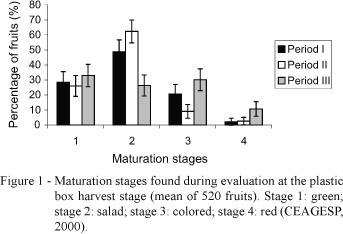Losses on tomato business chain start at harvest, a two-months period. At the beginning of the harvest, fruits concentrate at the basal part of the plant, then in the middle, and finally at the top, and undergo changes in diameter and maturity indexes as harvest progresses. The aim of this work was to evaluate the impact of handling at three different periods: (I) 15 days, (II) 30 days, and (III) 45 days after the beginning of harvest. Tomatoes were ordinarily grown and harvested in to bamboo baskets, and transferred to plastics boxes. Fruits were classified according to ripening stage and diameter, and evaluated for mechanical damage and external defects caused by harvesting procedures. The time required for the harvest operation was measured; damage to fruits (%) and weight loss (%), caused either in the field and/or during the harvesting process, were taken into consideration and related to the final quality of fruit after storage for 21 days. The same methodology was used all through the production and harvest cycle. The highest % fruit damage occurred during period II, a longer harvest time than the other two periods. Fruits not submitted to handling showed lower weight loss than handled fruits. Fruits harvested in period II and stored for 21 days showed higher losses due to mechanical injury.
Lycopersicon esculentum; losses; post-harvest; mechanical injury








